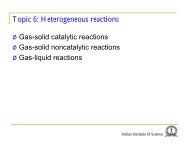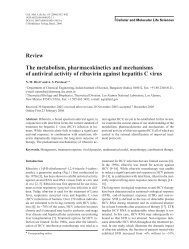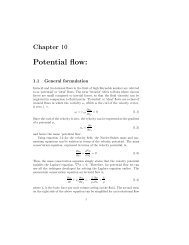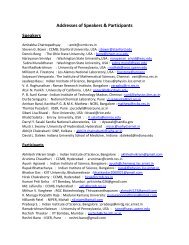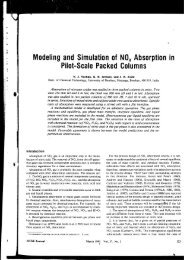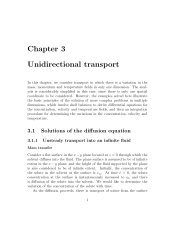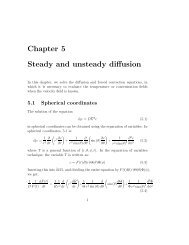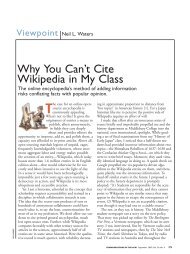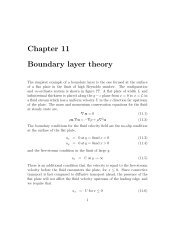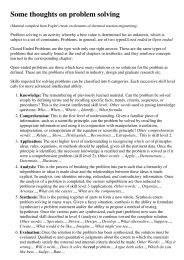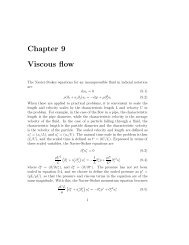14 CHAPTER 1. POTENTIAL FLOW:Using these it can easily be verified that the complex potential is,W(z) = (u r − ıu θ )exp (−ıθ) (1.12)Since we have shown that there are potential <strong>flow</strong> velocity fields associatedwith any analytic complex function, we can examine the potential <strong>flow</strong> fieldsdue to some fundamental forms of the function F(z). We first consider the form,F(z) = Az m (1.13)where A is assumed to be real without loss of generality. The derivative of F(z)with respect to z is,W(z) =dFdz= mAz m−1= mAr m−1 exp (ı(m − 1)θ) (1.14)Comparing the form of W(z) in equation 1.14 with that in equation 1.12, wefind that the velocities u r and u θ in a polar co-ordinate system are,u r = Ar m−1 cos(mθ)u θ = Ar m−1 sin (mθ) (1.15)Equations 1.15 represent a <strong>flow</strong> that, for positive A, is directed radially outwardfor θ = 0, radially inward for θ = (π/m), and along the θ co-ordinate forθ = (π/2m), as shown in figure ??. Since the normal velocity is zero along thelines θ = 0 and θ = (π/m), the velocity field 1.15 represents the <strong>flow</strong> in a cornerof subtended angle (π/m). Several special cases can be considered for specificvalues of m. For m = 1, the subtended angle is π, and the <strong>flow</strong> is a steadylinear <strong>flow</strong> with velocity A in the x direction, as shown in figure ??. The <strong>flow</strong>for m = 2 is the stagnation point <strong>flow</strong> in a corner of angle (π/2), as shown infigure ??. The <strong>flow</strong> for m > 2 is the <strong>flow</strong> in a corner with a subtended acuteangle, while the <strong>flow</strong> for 1 < m < 2 is the <strong>flow</strong> in a corner with a subtendedobtuse angle, as shown in figure ??.Next, we consider the formF(z) = m log (z) (1.16)2πwhere m is a real constant. The derivative of F(z) with respect to z is,W(z) =m2πz= m exp (−ıθ) (1.17)2πrComparing equation 1.17 with 1.12, we find that the components of the velocityfield are,u r = m2πru θ = 0 (1.18)
1.3. TWO-DIMENSIONAL POTENTIAL FLOWS: 15This is the <strong>flow</strong> from a point source of fluid in two dimensions, from which thetotal volume of fluid generated (per unit length in the third dimension) Q atany radius R is equal to m, and is independent of radius.A logarithmic function with an imaginary coefficient represents circulationabout the origin. Consider the form,F(z) =where Γ is real. The derivative of F(z) is,ıΓ log (z) (1.19)2πW(z) = − ıΓ2πz= − ıΓ exp (−ıθ)2πr(1.20)Comparing equation 1.20 with equation 1.12, we find the components of thevelocity,u r = 0u θ =Γ2πr(1.21)Thus, the <strong>flow</strong> due to the potential 1.21 is a circulating <strong>flow</strong> around the origin.For this <strong>flow</strong>, the circulation is the integral of the tangential velocity along aclosed curve around the origin, is equal to Γ.Circulation =1.3.1 Flow around a cylinder∫ 2π0rdθu θ= Γ (1.22)The motion around a cylinder translating with a velocity U x in the x directionin a fluid which is at rest at a large distance from the cylinder is expressed bya complex potential of the form,F(z) = − U xR 2z− ıΓ log (z) (1.1)2πThe velocity fields can be inferred from the derivative of this complex potentialwith respect to z,W(z) =dFdz= U xR 2z 2 − ıΓ(2πzUx R 2=r 2exp(−ıθ) − ıΓ2πr)exp(−ıθ) (1.2)



